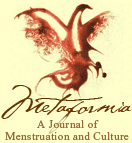What is Metaformia?
We think the world needs fresh new approaches to questions of the origins of culture, why humans differ from animals, why we are the marvelous, amazing, terrible, peculiar, cruel, kind, dangerous, and occasionally constructive beings that we are. So in this Journal we introduce Metaformic Theory because it is a new approach, one of several in the arena of menstruation and culture, but the one calling for the broadest changes in the way we think of human origins and processes through which we, and our ancestors, have attained the culture that surrounds us.
We want to engage in a dialogue with and about theorists of consciousness.
In this first issue we feature six articles related to Metaformic Theory. Judy Grahn’s “The Emergence of Metaformic Consciousness” gives an academic overview of some of the ideas encompassed in the theory, while Luisah Teish offers a personal account of how she searched for positive menstrual stories in African traditions, with roots in New Orleans; she outlines a coming of age ritual for girls. Deborah Grenn’s thealogical perspective is engaged in “Connecting with Deity Through a Feminist Metaformic Thealogy”. Mary Beth Moser traveled to Italy and Sicily to make her connections between miracles, Black Madonnas, and menstruation in “Blood Relics”; while biologist Tina Proctor has taken on the subject of Women, Orangutans and the Moon, and our fellow primates, the endangered orangutans. Judy Grahn’s impassioned “Are Wars Metaformic?” combines an entreaty for peaceful rites to replace warfare with the perception of a pattern of major national bloodshed every 28 years.
And, in the section called “Tidbits” we begin a series of anecdotal contributions on the subject of menstruation and culture. We accept articles on menstruation and culture that range from the scholarly to the personal, from Literature to Orature, from field studies, ethnographies, theologies and philosophies to the anecdotes we remember from our own family lineage.
Judy Grahn’s Metaformic Theory, and probably all theories of menstruation and culture rely on myths and folk stories, and on religious practices as well as on scientific reasoning and studies of artifacts, hormones or primate behaviors. Above all, those of us raised in families who in the distant past lost their memories of menstrual origins of culture, must rely on the sustained knowledge and memories of indigenous peoples—for which we are grateful. Judy Grahn’s book Blood, Bread, and Roses: How Menstruation Created the World is now online and soon will be downloadable, at no cost.
So we are multiple-genre, and multi-disciplinary in our approach to what we think is one of the most important subjects to surface in modern times: the reclamation of women’s rites as essential to our humanity, and of men’s rites as parallel to them.
Metaformic Theory is important because:
-
Metaformic Theory returns women to a crucial place in cultural origin stories, in our histories, in our rituals, in our religions, and in the ordinary and extraordinary everyday things that billions of women do all over the planet—so women can again identify themselves as being part of culture creation in major, leading, and centralizing ways.
-
Men are not displaced from a crucial role in cultural origin stories by this theory, nor are they demonized. The cultural contributions of men, as with women, are put into the perspective of ritual, and so both sexes have a better chance of understanding each other.
-
Menstrual theories teach that synchrony is a primary basis for evolution, women’s solidarity and intelligence, rather than our isolation, weakness or sinfulness, are emphasized. Women can help each other lose the shame and confusion of not knowing where we fit in as culture movers and shakers, and become engaged, active participants. This encourages and enables women to, for example, intelligently struggle to gain a full measure of control within institutions that affect them related to health and our bodies, motherhood, sexuality, the economy, marriage, education and children’s welfare, religion, government, science, the military, the welfare of the planet, and so on.
-
Menstrual theories teach that synchrony is a primary basis for evolution, women’s solidarity and intelligence, rather than our isolation, weakness or sinfulness, are emphasized. Women can help each other lose the shame and confusion of not knowing where we fit in as culture movers and shakers, and become engaged, active participants. This encourages and enables women to, for example, intelligently struggle to gain a full measure of control within institutions that affect them related to health and our bodies, motherhood, sexuality, the economy, marriage, education and children’s welfare, religion, government, science, the military, the welfare of the planet, and so on.
The editors wish to thank Laura K. Brown for being with us through two years of meetings, and Vanessa Tiegs for her painting and her stunning gallery of menstrual paintings. Special thanks to Dianne E. Jenett and Kris Brandenburger for editorial assistance.
